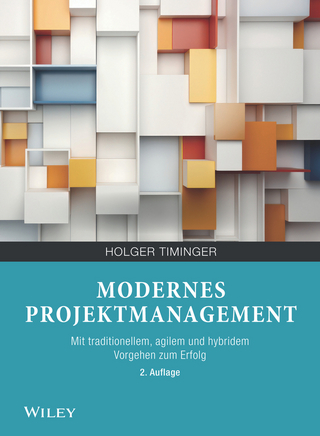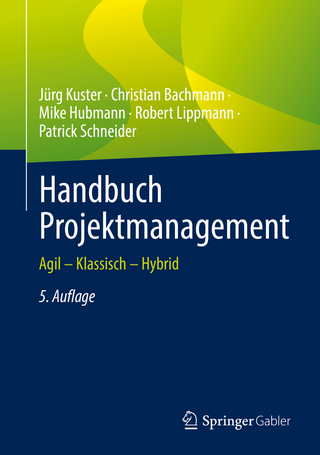
Project Management Tools and Techniques
CRC Press (Verlag)
978-1-138-58231-6 (ISBN)
- Keine Verlagsinformationen verfügbar
- Artikel merken
The first five sections discuss a typical project life cycle, and beginning with an introduction to project management in terms of the role it plays in the organization and how a business case drives the process. From this starting point, the various planning and control-oriented techniques described evolve this process through the life cycle from scope development to completion. The final section closes the discussion with a group of more contemporary topics labeled "advanced." These are essential tools that need to be in wide use but are still evolving in practice. Most of the chapters supply sample questions and exercises to help with a review of the material.
Each of the authors has extensive real-world experience in her or his respective professional areas with a combined experience of about 100 years. They have selected topics based on their valuation of the tool and its project management value. They present the material in such a way that the concepts can be applied to any project. Once this material is mastered, students will have a good overview regarding the basic planning and control actions required by a project manager. Also, this book will make a great reference guide that can be used by project managers and team members for years to come.
ROLE OF THE PROJECT
Learning objectives
Overview
Reference
Role of the Project
Introduction
Section I—Role of the Project
Section II—Project Formulation Using Tools and Techniques
Section III—Developing Project Scope
Section IV—Tools and Techniques for Developing the Project Plan
Section V—Project Execution
Section VI—Advanced Tools and Techniques
Appendices Section
Summary
References
Project Management in a Nutshell
Introduction
Methodology
Project Requirements Definition
Workshops
Brainstorming
Understanding the Project Business Case
Project ranking matrix
How to Evaluate and Prioritize IT Project Proposals
Quality Management
Microsoft Project 2010
Challenging
References
Power and Politics
Root Cause of Power and Politics
Organizational Structures
Summary
References
PROJECT FORMULATION USING TOOLS AND TECHNIQUES
Learning Objectives
Overview
Picking the right projects
Introduction
Nonfinancial Decision Models
Summary
References
Gaining support for a project
Management Approach
Project Manager
Stakeholders
Project Sponsor
Project Charter
Summary
References
Section III: Developing project scope
Defining a Project
Scope Planning and Definition
Staffing and Team Management
Summary
References
Developing the work breakdown structure
Introduction
Defining project work units
Role and structure of the project WBS
WBS decomposition mechanics
Sample WBS
WBS numbering scheme
WBS structure model comparison
WBS dictionary
Other WBS views
Project templates
Project scope baseline
WBS design exercise
Summary
References
Activity estimating
Introduction
Cost Estimating
An Estimate for Digging a Hole
Definitional Process
Estimate Creation
Estimating Components
Estimating Checklist
Summary
References
TOOLS AND TECHNIQUES FOR DEVELOPING THE PROJECT PLAN
Learning Objectives
Overview
Model Schedule and Cost View
Chapter Sequence
Creating the Project Schedule
Introduction
Work Activities
Sequencing Activities
Software Modeling
Predecessor Relationship Codes
Work Unit Resources
Estimating Activity Durations
Developing the Project Schedule
MSP Schedule Generation Mechanics (Stage One)
Sample First Cut Schedule Problem
Results for the First Cut Plan
Critical Path
Summary
Supplementary Technical Reference
References
Creating the Project Budget
Introduction
Key Terms
Cost Allocation Mechanics Example
Budget Overruns
Cost Accuracy
Cost Capture Process
Resource Components
Resource Pool
Resource Analysis
Pool Project Example Problem
Dealing with Murphy’s Law
Variability Sources
The Total Project Budget
Summary
Practice Exercise
References
Introduction to Risk
Risk Management
Formal Risk Legislation
Project Risk Management
Risk Identification
Risk Register
Summary
References
Creating a Viable Project Plan
Plan Tweaking Strategies
Summary
References
Finalizing the Project Plan
Reviewing the Project Plan Components
WBS Control Structure
Reserve Funds
Budget Structure and Format
Management Control Structure
Budget Categories
Project Repository
Final Project Plan Format
Communicating The Plan
Planning Stage Close
References
PROJECT EXECUTION
Key Performance Indicators
Earned Value
Status Tracking
Influencing Project Outcomes
Integrated Change Control and Scope Management
Resource Leveling
Summary
Key Performance Indicators
Introduction to KPIs
Developing KPIs and KPQs
Metrics, Measures, Critical Success Factors, and KPIs
Selecting KPIs
Analytical Hierarchy Process
KPIs as Individual Performance Measures
Data Collection
KPI Graphics
Summary
References
Chapter 15 Earned Value Management
Introduction
Basic EV Principles
EV Framework
EV Notation
EV Core Status Formulas
Gantt Bar Example
Critical Ratio
Performance Evaluation and Forecasting Parameters
MSP Mechanics
Using a Spreadsheet Plan to Calculate EV Parameters
EV Earning Rules
Labor Efficiency and Rate Analysis
Earned Schedule
EV Work Unit Component Interpretation
Project Operational Data Repository
Summary
References
Other Earned Value Reference Sources for Further Reading
Project Tracking Status
Introduction
Status reports
Issue log
Project Plan Communications
Project Statistics and Baselining
Text-Based Reports
Visual Reports: Excel
Visual Reports: Visio
Summary
References
Techniques to Influence the Project Outcome
Introduction
Scope Management
Project Management
Schedule Management
Summary
References
Integrated Change Control
Introduction
CRs and change boards
CM in ICC
ICC process
ICC costs
Summary
References
Resource Leveling
Introduction to resource leveling
Managing resource leveling
Resource leveling reallocation examples
Summary
References
ADVANCED TOOLS AND TECHNIQUES
Variable Time Analysis
Simulation Modeling
Risk Mechanics
Team Tools
Enterprise PMO
Summary
Variable Time Project Planning
Introduction
PERT History and Theory
PERT Mechanics
Project Schedule Range Quantification
Triangular Distributions
Using Macros for Calculation
Summary
References
Simulation Modeling
Introduction to Simulation Modeling
Monte Carlo
Executing the Model
Summary
References
Risk Mechanics
Risk Management
Risk Analysis
Risk Response Planning
Risk Monitoring and Control
Summary
References
Team Tools: RAM Charts and Staffing Profile
Organizational Definition
Roles and Responsibilities Matrix
Tracking Tools and Techniques
Project Close-Out
Summary
References
Enterprise Project Management Office
Introduction
Project, Program, and Portfolio Management
Prioritize Projects to Align with Strategic Plans
Moving to the Enterprise Project Management Office (or the Rough Road Going from Point "A" to Point "B")
Summary
References
Appendix A: MS Project Lab Assignment: A Life Cycle View
Appendix B: MSP 2010 Commands
Appendix C: Templates
Appendix D: MS Project Add-In Utilities
Appendix E: Variable Time Macro
Appendix F: Text Support Systems
Index
| Erscheint lt. Verlag | 31.12.2023 |
|---|---|
| Zusatzinfo | 68 Tables, black and white; 144 Illustrations, black and white |
| Verlagsort | London |
| Sprache | englisch |
| Maße | 152 x 229 mm |
| Themenwelt | Kunst / Musik / Theater ► Design / Innenarchitektur / Mode |
| Technik ► Maschinenbau | |
| Wirtschaft ► Betriebswirtschaft / Management ► Projektmanagement | |
| ISBN-10 | 1-138-58231-X / 113858231X |
| ISBN-13 | 978-1-138-58231-6 / 9781138582316 |
| Zustand | Neuware |
| Informationen gemäß Produktsicherheitsverordnung (GPSR) | |
| Haben Sie eine Frage zum Produkt? |
aus dem Bereich


